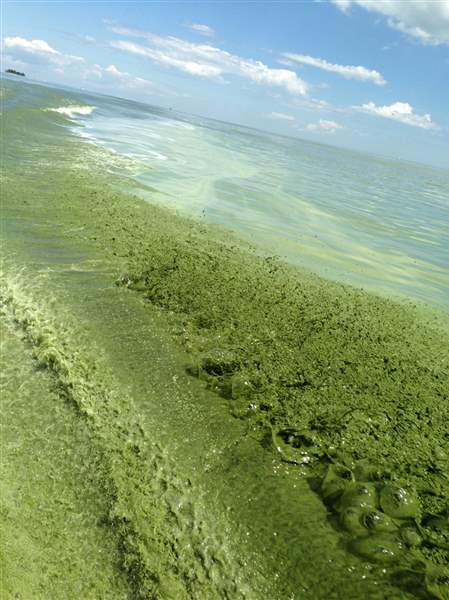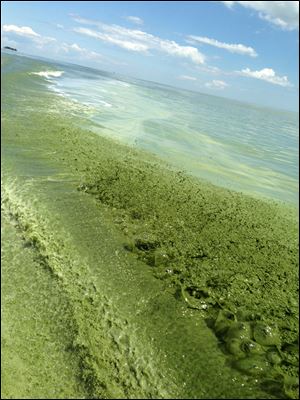
Algae outlook for Lake Erie not encouraging
5/15/2014
Algae in Lake Erie shown in the wake of a boat on Maumee Bay in August, 2013.
Photo Courtesy of Rick Butera

Algae in Lake Erie shown in the wake of a boat on Maumee Bay in August, 2013.
COLUMBUS — Although the first official forecast for western Lake Erie's 2014 algae is not scheduled to be made by government scientists and academic researchers until July 10, one of the principals involved in tracking that issue said today that phosphorus-runoff data being generated at a monitoring station along the Maumee River near Waterville is painting a grim picture.
Phosphorus loading through that station has run well-above average through May 1 and virtually parallels the level of runoff recorded through that date during the record algae bloom of 2011, according to Jeff Reutter, director of Ohio State University's Stone Laboratory and the Ohio Sea Grant program.
Scientists are closely watching those numbers to help better understand the volume of algae that will likely occur by late summer and early fall, in large part to help water-treatment plant operators know how to adjust their treatments to maintain safety in the public water supply.
The algae forecast also has become a bigger tool for anyone from fishermen to swimmers to businesses in the recreation and tourism industries.
Although phosphorus is not the only cause of algae, it is an important indicator because it is what primarily feeds it.
More than two-thirds of the phosphorus entering the Maumee River today is believed to come from agricultural runoff, Mr. Reutter said.
He noted a greater recognition of the issue by the agricultural community, but said it's obvious enough is not being done.
"These algae don't care where the phosphorus comes from," he said. "If it's warm and you give them a lot of phosphorus, you're going to get an algae bloom."
Mr. Reutter made his remarks to more than 200 people attending a climate change symposium today on OSU's West Campus, an event sponsored by the college's internationally known Byrd Polar Research Center.
The path of this year's phosphorus input is largely driven by rain, which Mr. Reutter said is expected to remain heavy during the most crucial period. Scientists have determined the runoff entering Lake Erie's tributaries between March 1 and June 30 has the most impact.
One of the lessons from last year, when the new forecasting system underestimated how much algae would form, was that a heavy load of phosphorus in July also can result in a large bloom, Mr. Reutter said.
The annual forecast is a project led by the U.S. Fish and Wildlife Service, in conjunction with other agencies and universities. The modeling is still being developed.
Jiyoung Lee, of OSU's Department of Public Health, said the toxin in western Lake Erie's most harmful algae, microcystis, can cause myriad health problems.
Contact Tom Henry at: thenry@theblade.com or 419-724-6079.